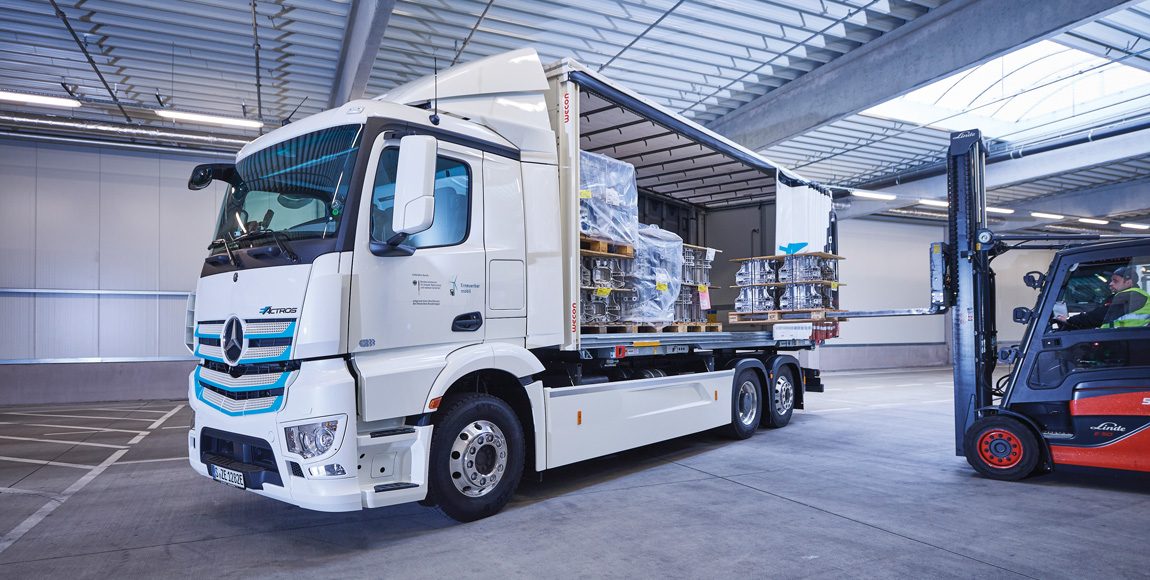Daimler makes tracks into the future

“Everything indicates we are on the right track”, was the message from the 2019 Daimler Truck & Bus annual press briefing. JARLATH SWEENEY from Fleet Magazine reports
The Daimler Truck & Bus annual press briefing is always an interesting affair, and the 2019 conference was made more interesting by the choice of venue, the Unimog Museum at Gaggenau, South West Germany (Daimler claims that the Gaggenau plant is the oldest automotive plant in the world).
As Daimler is a global company operating across all markets with a range of products that sell to a wide customer base, its annual report delivers an immediate and precise indication of how the various sectors within those markets are performing.
Martin Daum, member of the Board of Management, and responsible for Daimler Trucks & Buses, began
his presentation on a high note; commenting that “2018 was the most successful year in the history of Daimler Trucks”.
He reported record sales of 517 300 vehicles, realising a revenue of €38,3 billion (R613 billion), a figure significantly higher than 2017. An improved return on sales figure of 7,2 percent was also delivered in 2018, with earnings before interest and tax (EBIT) up from €2,3 to €2,7 billion (R36 to R43 billion).

While cautiously optimistic regarding the outlook for the remainder of 2019, Daum anticipated “a slight increase in unit sales and with the aim to achieve a return on those sales of seven to nine percent”. In 2019 Daimler intends to invest heavily in research and development (R&D) and Daum calls for legislation that supports the transport industry.
“We are committed to investing €1,4 billion (R22 billion)in R&D every year,” he commented, adding that Daimler will move directly from Level 2 (partial) automated vehicles straight to Level 4 (highly) automated.
“We think it is possible not only sometime soon, but realistically sooner than we realise and we have committed €500 million (R8 billion) to this technology. It will be only the beginning, and we have the funds to do it.”
Head of Mercedes-Benz Trucks, Stefan Buchner, continued with the good news and reported sales of
144 000 units stating that 2018 was the “best sales and order intake since 2008”.
In addition, he highlighted customer feedback that “describes the new Actros, which will hit the market in June, as the best package on the market”. He also stated that Mercedes-Benz has reduced costs by over
€400 million (R6,4 billion) and this will be realised in the 2019 figures.
Buchner then explained that Daimler’s FleetBoard Telematics business has acquired the “habbl” logistics software system developed by Eikona AG. “Our Digital Services and Solutions unit guarantees that our customers obtain the right solution for their needs from a single source. With habbl, we now have a new and pioneering product in our portfolio,” he explained.
One highlight of the event was the official handover of a fully electric Mercedes-Benz e-Actros 6×2 to Logistik Schmitt of Bietigheim. This 25-t gross vehicle mass (GVM) truck will run a daily route over three shifts between Otigheim and the Mercedes-Benz plant at Gaggenau, achieving a daily mileage of 168 km. When presenting the e-Actros to Logistik Schmitt, Buchner stated: “There is every indication we are on the right track.”
Being on the right track is becoming increasingly important for the company and this was clearly explained by Manfred Schuckert, who gave an overview of the industry’s current discussions with the European Council and the Commission on the subject of heavy-vehicle emissions and the methodologies used for measuring those emissions. Importantly, large passenger vehicles are not currently within scope of the proposals, though this may change.
The limits are measured using the Vehicle Energy Consumption Calculation Tool (VECTO). Within VECTO there are a number of parameters that take account of each vehicle’s specifications, on-board technologies and duty cycle.
From these parameters it is proposed that a baseline for vehicle emissions be set using new trucks registered from July 2019 to June 2020. The aim is to then reduce levels by 15 percent by 2025, with a total reduction of 30 percent by 2030, with all figures to be reviewed in 2022.

The subject is highly complex and, while nothing is agreed, negotiations are ongoing and agreement on final tolerances is expected soon. However, what is known is that if a manufacturer exceeds the agreed limits, the proposed penalties are punitive, to say the least.
At present, it is suggested to levy a fine of €4 000 (R64 000) per gram/tonne kilometre (gtkm) over the agreed limit between 2025 and 2029. This amount may increase to €6 800 (R108 000) per gtkm from 2030.
Schuckert explained that if a particular model exceeds the agreed limits by just one gtkm, and the manufacturer produces 40 000 units of that model, the company is liable to a fine of up to €160 million (R2,5 billion).
“What is coming will change the industry a lot, and we will need to put new technology into these vehicles, and this will mean that vehicles will become more expensive,” he concurred. This point was also noted by Daum, who added the reductions in CO₂ will make transport more expensive, and this must be communicated.
It is easy to see why manufacturers such as Daimler are directing resources towards alternative drivetrains. What does not seem to be appreciated is that the industry has already delivered dramatic reductions in emission levels. In 1996, average fuel consumption of the Euro-1 Mercedes-Benz SK 1844 was 40,8 l/100 km, and today, the equivalent truck, a Euro-6 Actros 1845, achieves 31,9 l/100 km – a reduction of almost 22 percent.
The main question from the event is: Are Daimler and Mercedes-Benz on the right track, as Buchner claims? It would appear so, as far as the figures and financial reports read. Sales are positive and the company is investing heavily in future technologies and alternative drivelines to ensure it stays on the right track when the environment gets tough.
Published by
Focus on Transport
focusmagsa




